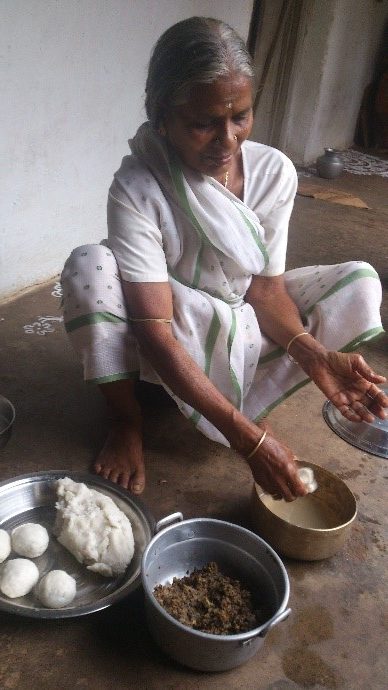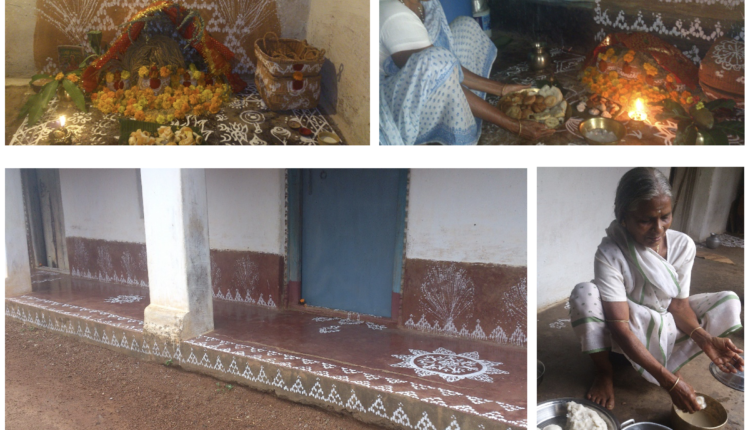Laxmi Puja ମାଣବସା
Laxmi-puja maanabasha in Odisha: Festival of harvest
Rabi Narayan Subudhi,
Professor, School of Management, KIIT Bhubaneswar
[written exclusively for KSoM blog, available at: https://blog.ksom.ac.in/2021/06/laxmi-puja-maanabasha-in-odisha-festival-of-harvest-rabi-narayan-subudhi/
Rural Odisha is best known for its unique festivals, celebrated religiously, with devotion. One of such festival is maanabasha (ମାଣବସା), also known as Laxmi Puja, observed on the last Thursday of the month of Margashira (ମାର୍ଗଶିର ଗୁରୁବାର), (mostly falls during November). This is very popular among farming community of agrarian rural society of Odisha (and more predominantly in coastal Odisha). This is the formal occasion of thanking Goddess Laxmi for good harvest and prayers for better harvest in the years to come. Harvest after the very hard work of farmer, is offered first to Goddess Laxmi, in the form of delicious cakes (pithaa – ପିଠା), of various types.
Maana: Maana (ମାଣ) in Odia has mostly two meanings (related to farming community): 1. a unit of measurement to measure land (maana – ମାଣ, guntha – ଗୁଣ୍ଠ, biswa..etc. are portions of an Acre); 2. Unit of measurement of paddy (maana, gauni – ଗଉଣି, bharana – ଭରଣ, etc.). Second form is a container made of bamboo cane. This container (maana, ମାଣ) is symbolically worshipped, inviting Goddess Laxmi. This festival is being celebrated with full devotion, since centuries. This is evident from early literature, particularly by legendary Fakir Mohan Senapati’s writings, during 1860’s (particularly in his serial turned novel, Chha Maana Atha Guntha). Keeping ‘maana’, cleaned and with colourful jhoti/ rangoli, with paddy and worshipping with offering of at least 14 types of cakes (all made of rice), is called Maanabasha Laxmipuja.


Pic-1,2: Senior ladies of house cleaning ‘maana’ one-day before Maanabasha Laxmi-puja. Painting is done using only natural colours (colour soil & rice paste).


Pic.3,4: Maana painted and ready to be used for puja.
Process: Laxmi puja is believed to be most auspicious by all ladies of farming communities. They observe it with utmost care and devotion. Preparation starts before 2,3 days of (Gurubar) Laxmi Puja day. Entire house gets a colourful look with jhoti/ rangoli. Courtyard and backyard and all walls look so colourful, all with natural colour, mostly made of rice paste. Ladies also grind rice making and keeping sufficient quantity of rice powder, for preparing various cakes (pithaa– ପିଠା). Just the previous day (Wednesday afternoon), maana (in different sizes, as shown in picture-3,4) taken from safe/ sacred place and washed with clean water. Then senior ladies paint it (as shown in picture-1,2) and get it dried so that it is ready for worshipping, next day, early in the morning.
Cake (- ପିଠା) making actually starts early, before 1,2 days, prior to puja-day, for distribution among all relatives. Special cakes, meant for puja, are made during very early morning of Thursday. Ladies get up and take bath as early as 4 am and start preparation. Entire street/ village would come to know about this puja early in the morning, by the chanting of hula-huli (ହୁଳ ହୁଳି) and mantra. Different types of cakes are made for puja (like, mandaa – ମଣ୍ଡା , kakara, arisha, chakuli, poda-pitha, etc.).[Ref. Pic- Ladies offer all cakes to Goddess Laxmi, complete puja and only after that they eat.


Pic:5,6: Jhoti/ rangoli made by using rice paste/ powder, natural colours only.


Pic: 7,8: Laxmi puja
Post-puja cake distribution is unique in itself, where youngsters and little kids compete to take charge of distribution of different cakes (pithaa – ପିଠା) and relatives and neighbours. It is also a chance for the young kids to get appreciation and sometimes return gifts from close relatives.


Pic: 9 [House decorated], Pic-10 [Cake making: Mandaa (ମଣ୍ଡା) pitha].
Mythology: This important festival, Laxmi puja, has a mythological belief, linking the ruling deity of Odisha, Lord Jagannath and his wife, Maa Laxmi. As many of us might be knowing, as written in Laxmi purana, Lord Jagnnath’s elder brother Lord Balaram disapproved and was very much angry as Maa Laxmi visited one so called ‘un-touchable’ Shriya (belonging to chandaal family) and prohibited Maa Laxmi, not to enter Sri-mandira. Laxmi wanted to teach both the brothers (Jagannath & Balaram) and saw that they suffered immensely for their false ego and made them to learn and repent. Both brothers could not get anything to eat. All started calling them Laxmi-chhadaa (ଲକ୍ଷ୍ମୀ ଛଡା).
Maa Laxmi was in fact impressed by the cleanliness and devotion of Shriya. Message here, what we learn, is ‘we should be clean, both physically and mentally’.
Laxmi puja inculcates cleanliness and devotion among those who believe it and celebrate. [Dt.17.6.21]
[Pictures by author]

